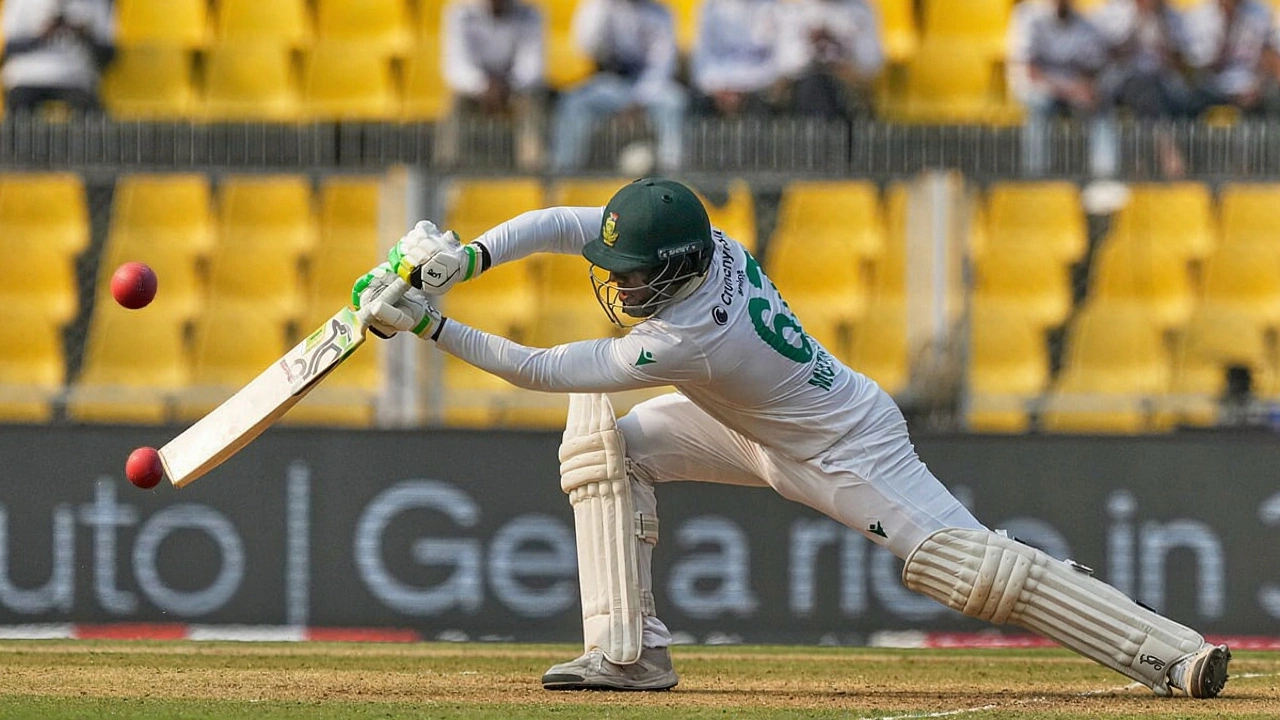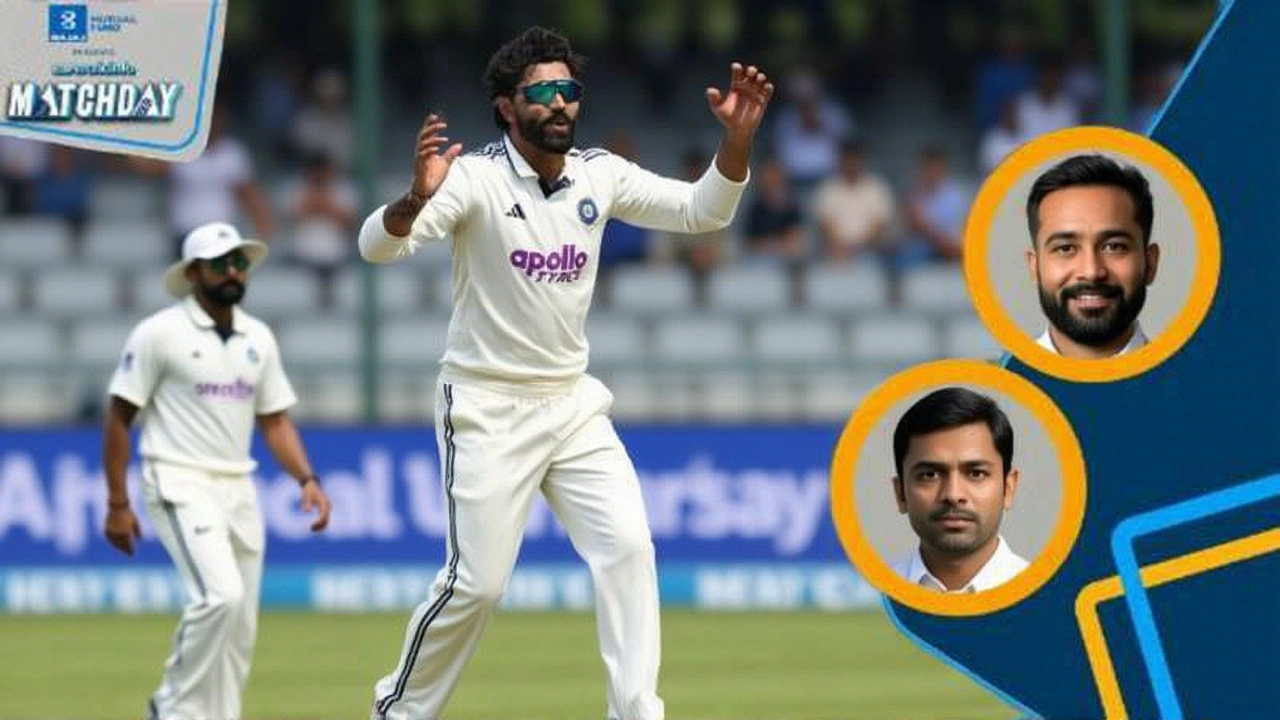On a quiet Sunday evening in Guwahati, a single ball changed the rhythm of an entire Test match. Senuran Muthusamy, on 48 runs and facing elimination, survived not by luck, but by the quiet hum of ultra-edge technology. The moment came on the second ball of the 104th over, just after 3:37 PM UTC on November 23, 2025, at the Barsapara Cricket Stadium. Ravindra Jadeja spun a 92 km/h delivery that gripped the surface, beat Muthusamy’s sweep, and crashed into his front pad. The Indian field erupted. Captain Rishabh Pant screamed for the lbw. The on-field umpire raised his finger. But then — the review. And the twist: it wasn’t bat. It was glove.
The Glove That Changed the Game
The DRS replay showed it clearly: a faint, almost imperceptible scratch on the ultra-edge graph. Not the clean spike of a bat edge. Not the flatline of pad contact. A whisper of contact — the kind you might miss if you weren’t watching for it. Chris Gaffaney, the New Zealand TV umpire and ICC Elite Panel veteran, didn’t hesitate. Out went the lbw. In came the relief. Muthusamy, who’d been visibly shaken moments before, exhaled. He didn’t celebrate. He just nodded. That’s the thing about Test cricket — sometimes survival is the bravest thing you can do."Around the noise and the emotion, I was just really disappointed," Muthusamy told Star Sports later. "When I was standing with Verreynne, I said, ‘You know, it might’ve just brushed my glove.’ I didn’t feel it right away. But when it came up on the screen... yeah. That little scratch? It was everything."
A Decision That Split the Room
In the commentary box, former India selector Saba Karim didn’t mince words. "Even if there is a slight murmur, they could figure out that this is off the gloves, not off the wood. And, I think, that is why the TV umpire gave that decision. I thought that was a fine decision." His words carried weight. Karim, who once stood behind the stumps for India in the 1980s and later shaped selection policies, knew the difference between a bat and a glove. He’d seen enough DRS controversies to know when the system worked — and when it didn’t. This, he said, was one of the rare times it did.But in the Indian dressing room? Not so much. Pant, arms flailing, gestured toward the pavilion like a man arguing with fate. Ishan Kishan, the young wicketkeeper, was seen shaking his head, disbelief etched on his face. The Indian fielders, who’d been certain, now stood still — some rubbing their eyes, others glancing at the replay screen. One bowler muttered, "That’s not glove. That’s bat." But the tech doesn’t lie.

From Survival to Century
Muthusamy didn’t just survive. He seized the moment. He went on to score 109 — his maiden Test hundred — off 206 balls, with 13 fours and two sixes. It wasn’t just a personal milestone. It was a team lifeline. South Africa, resuming Day 2 at 247-6, ended the day at 489 all out in 151.1 overs. And for the first time in Test history, two South African batters at number seven or lower — Muthusamy and Marco Jansen (93) — both crossed fifty against India. Kyle Verreynne added 45. Together, they turned a precarious 247-6 into a commanding total.The pitch, which had offered turn early, flattened out by the second morning. Jadeja (2/78 in 27 overs) and Kuldeep Yadav (3/110 in 36.1 overs) worked hard, but the ball didn’t grip like it had on Day 1. The DRS decision didn’t just save Muthusamy — it changed the entire dynamic of South Africa’s innings. Momentum shifted. Confidence rose. India’s attack, which had looked dominant, now looked frustrated.
India’s Response and What Comes Next
At stumps, India had reached 9/0 in 3.1 overs. Openers KL Rahul and Yashasvi Jaiswal saw out the fading light. The pitch, now dry and slow, will offer little help to the bowlers. India will need to bat long — very long — to have any chance of forcing a result. But with South Africa’s tail wagging and the DRS controversy still echoing, the pressure is mounting."We’re not panicking," said Pant after play. "We’ve been here before. We know how to handle these situations. But we also know — when the tech says glove, you accept it. Even if you don’t like it."

Why This Matters Beyond the Scoreboard
This wasn’t just about one review. It was about trust. Trust in technology. Trust in umpires. Trust in the spirit of the game. For years, fans have argued that DRS favors batters. That it’s too lenient. That it takes away the human element. But this moment? It proved the opposite. Without DRS, Muthusamy would’ve been out. South Africa’s innings would’ve collapsed. India might’ve won by an innings. The match might’ve ended on Day 3.Instead, we got a century. We got history. We got a debate that will echo through dressing rooms and TV studios for weeks. And we got a reminder: sometimes, the smallest contact — a graze, a brush, a whisper — can change everything.
Frequently Asked Questions
How did the ultra-edge technology confirm the glove contact?
Ultra-edge uses synchronized high-speed cameras and sound sensors to detect minute vibrations. When the ball contacts the bat, it produces a sharp, loud spike. A glove contact creates a softer, shorter waveform — often called a "scratch" or "flick." In Muthusamy’s case, the graph showed a faint, non-symmetric spike consistent with glove contact, not the clean, loud peak of bat-edge. The system’s accuracy rate exceeds 98% in such scenarios.
Why was Saba Karim’s opinion so influential?
Karim wasn’t just a former player — he was India’s national selector from 2012 to 2016, responsible for picking teams during a period of aggressive DRS adoption. He understands both the technical side and the psychological weight of umpiring decisions. His endorsement carried authority because he’s seen dozens of controversial reviews and knows when the system works as intended — not when it’s misused.
What’s the significance of South Africa’s No. 7 and No. 8 both scoring half-centuries against India?
It’s the first time in Test history that two South African batters ranked seventh or lower have both passed fifty against India. This highlights a rare depth in their batting lineup — a shift from their traditional reliance on top-order firepower. Jansen and Muthusamy’s partnership (138 runs) broke India’s pattern of dismissing lower-order batters quickly, especially on turning tracks.
How did the pitch condition influence the match outcome?
The Barsapara pitch, known for early spin, had turned sharply on Day 1, helping Jadeja and Kuldeep take early wickets. But by Day 2 morning, it had flattened dramatically. The ball stopped spinning, lost grip, and became easier to drive. This allowed Muthusamy and Jansen to play freely. Without that flattening, South Africa’s total might’ve been under 350 — making the DRS decision even more pivotal.
What’s the next key moment to watch in this Test?
India’s ability to bat through Day 3 will determine everything. If Rahul and Jaiswal survive the new ball, and the middle order builds a big total, India can still force a win. But if South Africa’s spinners — particularly Keshav Maharaj — exploit the dry, worn surface, India could collapse. The DRS decision gave South Africa a 150-run advantage. Now, India must erase it — without the benefit of a turning pitch.
Has this kind of glove-vs-bat DRS decision happened before in India vs South Africa Tests?
Yes — but rarely. In the 2019 Test in Johannesburg, Faf du Plessis survived an lbw review after the ball brushed his glove, a decision that sparked similar outrage. But in India, such decisions are rarer because pitches usually favor spin and the ball tends to hit the pad squarely. This was only the third such instance in India since 2015 where glove contact was confirmed over bat — and the first time it led to a century.
